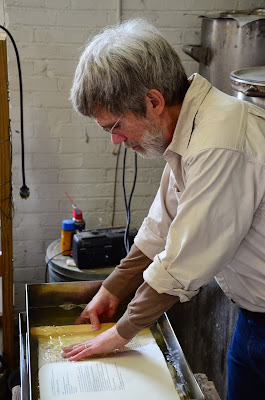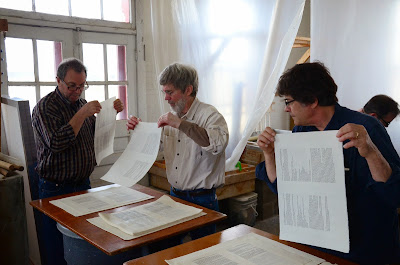A few weeks ago I hit the road for Iowa City to help Tim Barrett finish the gelatin sizing on the
Hungry Bibliophiles paper, and to cart the sized sheets back to New York City for binding. Gaylord Schanilec and David Esslemont (both participants in the project) happened to be in New York for the Manhattan Fine Press Book Fair, so we packed our gear in the car and headed for the prairie together. After seeing our many Facebook posts along the way, Peter Koch (another hungry bibliophile) hopped on a plane for Cedar Rapids and met up with us for a couple of days of work, student meetings, and socializing.
Gaylord Schanilec, Russell, Peter Koch, and David Esslemont enjoying refreshments at Emily Martin's house after a busy day at the UICB paper facility. Photo: Sara Sauers.
The paper that we used for the book is the University of Iowa Center for the Book's BHC 20-80 Chancery paper, which is made from 20 percent textile quality hemp and 80 percent textile quality cotton. The unbleached fibers are cooked in lime and washed during beating. Once the fibers are prepared, the complex process of sheet forming and sizing are as follows:
1) The paper is usually made in batches of 300 sheets.
2) The sheets are parted from the felts and pack-pressed (damp sheets only with no felts) in a screw press until they weep.
3) The paper is separated sheet by sheet.
4) And the sheets are hung to dry in groups of 4 loose sheets.
5) If printing prior to sizing, the sheets are now printed. (If printing after sizing, this step is removed from the papermaking schedule.)
6) The sheets are dredged 10 at a time through a liquid solution of photo-grade gelatin. (In our case between 3-3.5% gelatin. [This step is done in batches of roughly 150 sheets.])
Tim Barrett submerging 10 sheets of paper in the gelatin bath. Photo: John Deason.
7) The gelatin-soaked sheets are stacked and kept under a warm-gelatin-infused felt to keep the gelatin from drying.
Tim and I stacking the gelatin-soaked sheets.
8) The sheets are pressed in a screw press to remove excess liquid.
Tim and I placing the sized sheets into the screw press.
9) While the gelatin is still wet, the sheets are individually separated and gently fluttered in the air to set the gelatin. This prevents the sheets from sticking together.
David, Tim, Gaylord, and I separating the sized sheets one at a time. Photo: John Deason.
10) The sheets are hung to dry.
Gaylord hanging the sized sheets.
When dry, the sized sheets are rigid like potato chips.
11) The dry sheets are humidified in an enclosed area to soften the paper.
Tim humidifying the sized sheets.
12) The softened sheets are then smoothed by hand and stacked inside a plastic bag.
David and Tim placing the sheets in the plastic bag.
13) After which they are squeezed in a screw press for 30-60 minutes.
Tim pressing the humidified sheets.
14) The sheets are then removed from the bag, jogged, and returned to the bag.
15) And pressed in the screw press overnight.
16) The sheets are removed from the press the next day and hung to dry.
17) After which they are taken down, jogged, and dry pressed.
Once these steps were complete, Tim put the sized and unsized sheets through a fold endurance test and found that the sized sheets endured an average of 1,528 folds before breaking, as opposed to the unsized which averaged only 351 folds.
The fold endurance tester.
With the paper sizing complete, I packed the sheets into the car and headed back east to fold and collate the books in anticipation of the whirlwind bind-a-thon we had scheduled. With each aspect of this project, speed has been a crucial element. Tim and I each believe—he with paper, and I with type design—that the element of non-Industrialized speed added a great deal of the character to which we respond in pre-Industrial books. Inspired by Tim's attempts to produce 100-200 sheets of handmade paper per hour, I designed the roman and italic typeface for the book (a revival of Peter de Walpergen's Cannon type) in sixteen hours, with no further revisions. Continuing on this theme, Maria Fredericks designed a historically inspired long stitch binding for the book, with the hope of binding the entire edition in two days. For this task we assembled a team of eight binders: Maria Fredericks, Anne Hillam, Yukari Hayashida, Nancy Loeber, Vasaré Rastonis, Gaylord Schanilec, Annie Schlechter, and me. Under Maria's careful direction, and fueled by Annie's sandwiches, the eight of us completed the seventy-nine books in sixteen hours of work.
The binding in process.
This week the books will ship out to the participants and we will all begin cooking. The goal is for each of us to cook all (or nearly all) of the recipes in the book in the space of one year, to do so with the books open on our countertops, and to annotate the recipes in the margins. At the end of the year, Annie will photograph the most interesting example of each spread and we will compile a print-on-demand facsimile.
_____
*Tim Barrett contributed greatly to the content of this post.



















